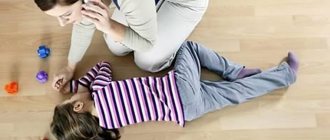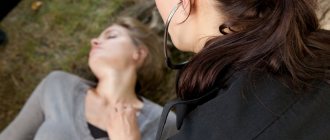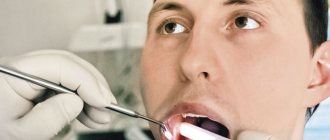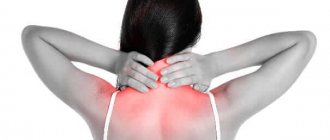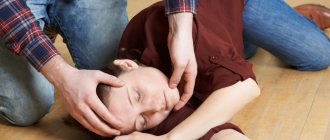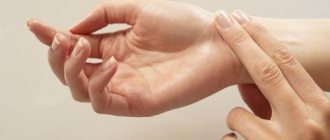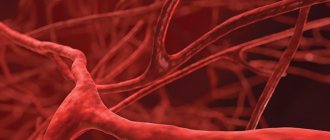Types of loss of consciousness
Loss of consciousness is classified as an abnormal condition that is characterized by loss of reflexes and disturbances in the functioning of the nervous system. Develops when there is a small amount of oxygen caused by problems with blood circulation. Quite often, against the background of this condition, a deterioration in the functioning of all existing reflexes develops. Loss of consciousness is characterized by the fact that a person falls and does not move (an exception may be an epileptic seizure or muscle twitching), there is no reaction to various irritating elements.
Fainting and loss of consciousness
The difference between these conditions is in the causes, provocateurs and consequences. Syncope is most often formed due to reversible disturbances in the supply of blood to cells, which are formed as a result of a sharp decrease in pressure.
Prolonged syncope, characterized by a prolonged lack of oxygen in the brain tissue, is based on severe organic disorders and provokes problems with vital functions.
| Parameter | Fainting | Syncope |
| Reason for formation | Problems with the nervous system, deterioration of blood supply to the brain against the background of a sharp drop in blood pressure | Diseases related to the functioning of the heart |
| Duration | A couple of seconds, but no more than five minutes | More than five minutes |
| Recovery speed | There is a rapid and absolute restoration of all reflexes, as well as physiological and neurological disorders | Recovery is slow and may not happen at all |
| Amnesia due to recent events, ECG changes | None | Present |
First aid if a person loses consciousness or faints
Loss of consciousness is a condition in which a person lies motionless, does not respond to questions and does not perceive what is happening.
When you lose consciousness, the part of your brain responsible for conscious thought shuts down. At the same time, the parts of the brain that control reflexes, breathing and blood circulation processes (in particular, the medulla oblongata) can work.
Loss of consciousness occurs with: - a significant lack of oxygen in the blood (or lack of blood) - a concussion (impact of the brain on the skull) - severe pain or nervous shock
Loss of consciousness can be caused by: overwork, hypothermia, overheating, lack of oxygen in the air, severe pain, deep emotional shock, dehydration (for example, due to severe diarrhea, vomiting), head injury, hemorrhage, electric shock or poisoning.
Typically, loss of consciousness does not occur suddenly. Most often, the human body shows the first signs in the form of dizziness, nausea, ringing in the ears, severe weakness, blurred vision, cold sweat, as well as a feeling of emptiness in the head and numbness of the limbs. The person begins to turn pale, his pulse weakens, and his blood pressure decreases. After which the eyes close, muscle tone disappears and the person falls.
What to do if you lose consciousness?
1. If you see that a person is losing consciousness, try to prevent him from falling and hitting his head.
2. Eliminate the factor that led to loss of consciousness (if it is still active). For example, take the person out of a stuffy room or open a window, move a live wire away from him, etc.
3. Place the person on the floor. He shouldn't sit! To ensure oxygen access, unfasten the collar and loosen the belt. Do not put anything under his head, or better yet, lift his legs up a little. This is necessary in order to facilitate blood flow to the brain.
4. Try to bring him to consciousness with the help of external stimuli - patting his cheeks, cold water or ammonia. If there is no ammonia, bring a cotton swab soaked in vinegar.
5. If he does not regain consciousness, check for breathing and pulse with two fingers on the neck (carotid artery)
6. If there is no breathing or pulse, perform artificial respiration and cardiac massage
7. If there is breathing and a pulse, turn the person on his side. This is necessary so that in case of vomiting he does not choke.
8. Call an ambulance
There is no need to treat loss of consciousness as a protective reaction of the brain (like, let him lie unconscious and rest). When you lose consciousness, irreversible changes can occur in the brain tissue. Therefore, if possible, you need to quickly return the person to consciousness.
It often happens that after fainting a person becomes embarrassed because a lot of attention is being paid to him and refuses further help. You should insist that he not be left unaccompanied anytime soon because the fainting spell may reoccur.
First signs
The following are signs that precede syncope:
- causeless anxiety, weakness, incessant yawning, heavy breathing;
- pale skin, sweating;
- headaches that bring a pressing or squeezing sensation, noise in the ears (ringing in the ears may be present), dizziness, hearing problems, suffocation;
- adrenaline rush, accompanied by heat at the end of the fingers;
- darkening before the eyes;
- tonic convulsions;
- a sharp increase or decrease in pressure, heart rate increases;
- nausea, vomiting, sour taste in the mouth.
Fainting is characterized by the presence of the following manifestations:
- the muscles are relaxed and the body is motionless;
- breathing slows down;
- blood pressure decreases;
- in case of deep fainting, the occurrence of convulsions and incontinence cannot be excluded;
- Pupils dilate, in the presence of serious pathologies, there is no reaction to light.
Main pathologies
Syncope is caused by insufficient supply of ozone to the brain, which is usually caused by the presence of disturbances in the functioning of the body.
Vagal loss of consciousness
Most often they develop with spasms that narrow the nutrient vessels or with a decrease in pressure, and does not depend on severe pathologies of an organic nature. Some of the least dangerous causes of syncope include the following:
- stress (painful sensations or their expectations, the appearance of blood, an uncontrollable state of fear up to panic attacks, nervous overstrain);
- reflexes: coughing, sneezing, pain during urine excretion, penetration of a foreign object into the throat, problems with bowel movements, serious exercise;
- vegetative-vascular pathologies that develop during panic attacks.
After this condition, all functions are fully restored, but severe fatigue and panic attacks may be present.
Cardiogenic causes
The main factor causing syncope in 25% of cases is heart disease. After loss of consciousness occurs, it is immediately necessary to undergo a thorough diagnosis, since if this is not done, then a serious illness can be overlooked.
Most often, the factor that provokes insufficient oxygen supply to the brain and the formation of syncope in diseases of a cardiogenic nature is a decrease in the number of blood during cardiac output (blood pushed into the aorta during one contraction). As a rule, syncope is formed due to serious illnesses caused by disturbances in the heart rhythm (arrhythmia or tachycardia is detected, in which the heart rate is more than 160 beats per minute).
Loss of consciousness of arrhythmic type
This kind of syncope is caused by the presence of the following pathologies:
- Paroxysmal tachycardia is a sharp increase in the number of myocardial contractions per minute (more than 150).
- Ari – characterized by a high probability of cardiac arrest. It is quite difficult to identify such a pathology, since by the time the cardiogram is performed, the paroxysm has already disappeared, and such a false diagnosis as physiological fainting can be made. This does not reduce the likelihood of death.
- Weakening of the sinus node (poor functioning of the central node that controls the rhythm of the heart).
- Atrial fibrillation and gastric fibrillation.
- SVC syndrome is characterized by a pathological path of impulse conduction in the myocardium.
With this kind of disease, rhythm problems arise and the saturation of brain cells with blood is interrupted.
Other reasons
Other causes of insufficient cardiac output include the following:
- problems with the functioning of the ventricles;
- a heart attack that provoked problems with muscle contraction;
- congenital or acquired defects of the heart structure;
- vascular thrombosis;
- atherosclerosis.
With prolonged weak functioning of the coronary vessels, ischemia is formed (cell death occurs). Atrophy of the active fibers of the heart is observed; they are replaced by connective tissue, which is characterized by increased density and is unable to contract. There is a decrease in the output volume, the brain cells do not have enough oxygen, which causes a loss of syncope.
What to do if you see an unconscious person
Confusion is the feeling that most people seem to experience when they see an unconscious person. At the same time, in reality it is quite easy to help: very simple and understandable algorithms have been developed for this. Of course, a person who has completed first aid courses can bring much more benefit, but everyone else, with the help of fairly simple manipulations, is able to naturally save the life of the victim. So, you see a person who lies and shows no signs of life. What to do?
The first rule that everyone forgets is to make sure you are safe. You will run towards a person across the sidewalk and collide with a cyclist. Or you will come across exposed wires near the victim. In general, make sure that you can provide help without harming yourself. If everything is fine, then first you need to understand whether this person really has problems: he can just sleep. To get his bearings, call him and shake his shoulder. Any ambulance worker will tell you that often people don’t do this, they immediately call an ambulance, and it goes to wake up sleeping homeless people or people in a state of intoxication. It seems that this is still not what such a service should do.
But now you shock the person - he does not answer. Then first of all you need to decide how serious it is. Perhaps it is a simple fainting, perhaps the person has died, perhaps his heart is beating incorrectly and he can still be saved. And in an amicable way, further actions should depend on whether the person is breathing or not. Many people immediately rush to check their pulse, but studies show that few people can do it well.
You need to check your breathing according to the following rules:
- turn the person onto his back; - support his chin, press on his forehead and thereby tilt his head back; - bend over and listen for 10 seconds to see if the person is breathing, while simultaneously watching to see if the chest rises.
If there is breathing, you need to put the person on his side and call an ambulance. This position will help him breathe: his tongue will not sink, and he will not be able to choke on vomit. In a situation where you have forgotten how to check breathing, and without this it is not clear whether a person is breathing or not, you can do the same.
How to properly turn an unconscious person onto his right side - Kneel next to him.
- Place his hand closest to you at a right angle to your body, palm up. — Throw the hand farthest from you over your head so that its palm touches the cheek closest to you. - Bend the leg farthest from you at the knee at a right angle. - Turn the person onto their side by pulling on the bent knee. At the same time, his hand farthest from you will protect his head from hitting the floor, and the closest one will not allow his body to roll more than necessary and lie face down. If there is definitely no breathing, then it means that the heart most likely is not beating, you need to call an ambulance and start resuscitation. If you have checked your breathing and hear some strange wheezing, then assume that it is not there. Ideally, you should also send someone to get an automated external defibrillator (AED) and begin chest compressions yourself. And there are several nuances here.
Firstly, if you do not know how to do chest compressions and are very afraid of causing harm by doing it incomprehensibly according to the dispatcher’s orders, then you can limit yourself to turning the person on his side.
Secondly, there are practically no AEDs in Russia (only in rare airports and companies), and the law that was supposed to promote their distribution is stuck in the State Duma.
Probably a lot of people are wondering right now: how can an untrained person use an AED and not kill? The good news is that this type of defibrillator does not shock everyone. This is a small device (no “irons” like in the movies, just stickers with electrodes that are attached to the chest), with simple instructions written on it, and usually in a voice, the defibrillator takes an ECG and asks everyone to move away if a shock is needed. A discharge may be necessary if a person has a serious heart rhythm disturbance (ventricular tachycardia or ventricular fibrillation) and the heart does not pump blood, but simply contracts chaotically. That is, an AED cannot restart a heart that is not beating, but it can restart a heart that is not beating properly. It makes sense to use an AED in the first 10 minutes after loss of consciousness (or better, in the first three). Sometimes several shocks are needed, and between them it is necessary to pump blood using chest compressions. By the way, mouth-to-mouth breathing is now not considered mandatory and dramatically increases a person’s chances of survival. If the rescuer is not trained, then mouth-to-mouth breathing is not recommended at all, especially since there should be enough oxygen in the blood until the ambulance arrives (of course, if this is the case when you are not far from civilization and the ambulance arrives quickly). Trained people can carry mouth-to-mouth breathing masks - they come in miniature sizes, which is very convenient.
In adults, indirect cardiac massage is performed with straight arms, clasping the hands with the knuckles up. In children this can be done with one hand, in infants - with two fingers. You need to apply pressure in the area of the lower half of the sternum (this is the area between the nipples). It is good when the chest is depressed by 5-6 centimeters (in infants - by 4 centimeters). Of course, you can break your ribs this way, but they will heal, and indirect massage can save your life. It is necessary to apply pressure at a frequency of 100-120 beats per minute. If you do this to the rhythm of the song Stayin' Alive, it will do what you need.
But all this cardiopulmonary resuscitation is, of course, very, very difficult to carry out correctly without training, so let us remind you once again about the courses: they are free, take place mostly on weekends, and you can discuss with your superiors the visit of a trainer to your organization. But as a last resort, you can use online courses and all kinds of videos for training. This is considered to be an acceptable alternative. In the meantime, if you use the Telegram messenger, you can contact the bot, which will quickly provide you with an action algorithm.
Summary
If you see an unconscious person:
- Make sure you are not in danger.
- Turn to the person and shake his shoulder.
- If not responding, check your breathing.
- If the person is breathing, turn them to a safe position and call an ambulance. If he is not breathing, call an ambulance, send someone for an AED and begin resuscitation.
Diagnostic features
A patient with frequent occurrences of syncope is examined in the hospital using an ECG to refute or verify that such a condition is cardiac in nature. During the diagnosis, the following conditions are noted:
- If a patient is under forty years of age and has no abnormalities in the cardiac structure on the cardiogram, then syncope is most likely caused by the presence of neurological disorders.
- If a patient over forty years old has no lesions on the cardiogram, then the examination still begins with a detailed study of the condition of the heart.
In addition, you need to know the following:
- syncope caused by physical overexertion is not safe for people of any age group;
- the older the patient who experiences syncope, the greater the likelihood of having serious cardiac problems that caused this type of condition;
- if the duration of cardiac interruptions to the point of fainting is more than 5 seconds, then such interruptions are signs of serious heart disease;
- uncontrolled muscle twitching is quite often caused by temporary cerebral ischemia caused by the presence of heart disease;
- Even short syncope if a person has heart disease is usually considered a serious symptom.
It is especially dangerous if syncope is accompanied by the following factors:
- painful sensations behind the chest;
- in 60 seconds more than 160 heart contractions;
- heavy sweating;
- slow heartbeat;
- low pressure.
Providing first aid to victims
Photo: Victor Vasenin
The manual of the Ministry of Emergency Situations of Russia will help participants in road accidents and eyewitnesses of a heart attack in a sick person not to get confused in a difficult situation. The book also lists algorithms for providing first aid for traumatic injuries and emergency conditions. Such as external bleeding from injuries, abdominal wounds, penetrating chest wounds, bone fractures and thermal burns, as well as hypothermia and frostbite. Readers will learn how to behave correctly in order to actually help someone who has been electrocuted, or has swallowed water in a river, or perhaps has become a victim of serious poisoning. The manual also contains recommendations for help in case of injuries and chemical burns of the eyes, bites of poisonous snakes, insects, as well as heat and sunstroke.
Priority actions when providing first aid to sick and injured people
First of all, assistance is provided to those who are suffocating, who have profuse external bleeding, a penetrating wound to the chest or abdomen, who are unconscious or in serious condition.
| Make sure that you and the victim are not in danger. Use medical gloves to protect the victim from body fluids. Carry (lead) the victim to a safe area. |
| Determine the presence of a pulse, spontaneous breathing, and the reaction of the pupils to light. |
| Ensure patency of the upper respiratory tract. |
| Restore breathing and cardiac activity by using artificial respiration and chest compressions. |
| Stop external bleeding. |
| Apply a sealing bandage to the chest for a penetrating wound. |
Only after stopping external bleeding and restoring spontaneous breathing and heartbeat, do the following:
| Call (on your own or with the help of others) an ambulance. Apply an aseptic (clean) bandage to the wounds. |
| Ensure immobility of body parts at the fracture sites. |
| Apply cold to the sore spot (bruise, fracture, wound). |
| Place in a restorative position, protect from hypothermia, give a warm, salted or sweet drink (do not drink or feed in the absence of consciousness and abdominal injury). |
Procedure for performing cardiopulmonary resuscitation
2.1. Rules for determining the presence of a pulse, spontaneous breathing and the reaction of the pupils to light (signs of “life and death”)
| Determine the presence of a pulse in the carotid artery. (There is a pulse - the victim is alive.) |
| Listen to breathing, determine the presence or absence of chest movements. (There is movement of the chest - the victim is alive.) |
| Determine the reaction of the pupils to light by lifting the upper eyelid of both eyes. (The pupils narrow in the light - the victim is alive.) |
Proceed to resuscitation only if there are no signs of life (points 1-2-3).
2.2. Sequence of artificial ventilation
| Ensure patency of the upper respiratory tract. Using gauze (handkerchief), remove mucus, blood, and other foreign objects from the mouth using a circular motion of your fingers. |
| Tilt the victim's head back. (Lift your chin while holding the cervical spine.) Do not perform this if you suspect a fracture of the cervical spine! |
| Pinch the victim's nose with your thumb and forefinger. Using a device for artificial ventilation of the lungs of the “mouth-device-mouth” type, seal the oral cavity, make two maximum, smooth exhalations into his mouth. Allow two to three seconds for each passive exhalation of the victim. Check whether the victim’s chest rises when inhaling and falls when exhaling. |
2.3. Rules for closed (indirect) cardiac massage
| Determine the location of the xiphoid process, as shown in the figure. |
| Determine the point of compression two transverse fingers above the xiphoid process, strictly in the center of the vertical axis. |
| Place the heel of your palm on the compression point. |
| Apply compressions strictly vertically along the line connecting the sternum to the spine. Perform compressions smoothly, without sudden movements, using the weight of the upper half of your body. |
The depth of chest compression should be at least 3-4 cm, 100-110 compressions per minute.
| - For infants, massage is performed using the palmar surfaces of the second and third fingers; - for teenagers - with the palm of one hand; - in adults, the emphasis is placed on the base of the palms, the thumb is directed towards the head (legs) of the victim. The fingers are raised and do not touch the chest. |
| Alternate two “breaths” of artificial pulmonary ventilation (ALV) with 15 pressures, regardless of the number of people performing resuscitation. |
| Monitor the pulse in the carotid artery, the reaction of the pupils to light (determining the effectiveness of resuscitation measures). |
Closed cardiac massage should only be performed on a hard surface!
2.4. Removal of a foreign body from the respiratory tract using the Heimlich maneuver
Signs: The victim is suffocating (convulsive breathing movements), unable to speak, suddenly becomes cyanotic, and may lose consciousness.
Children often inhale parts of toys, nuts, and candies.
| Place the baby on the forearm of your left hand, and clap the palm of your right hand 2-3 times between the shoulder blades. Turn the baby upside down and pick him up by the legs. |
| Grab the victim from behind with your hands and clasp them in a “lock” just above his navel, under the costal arch. Press sharply with force - with your hands folded into a “lock” - into the epigastric region. Repeat the series of pressures 3 times. For pregnant women, apply pressure to the lower parts of the chest. |
| If the victim is unconscious, sit on top of the hips and sharply press on the costal arches with both palms. Repeat the series of pressures 3 times. |
| Remove the foreign object with your fingers wrapped in a napkin or bandage. Before removing a foreign body from the mouth of a victim lying on his back, he must turn his head to the side. |
IF, DURING RESUSCIVATION, INDEPENDENT BREATHING, HEARTBEAT DOES NOT RECOVER, AND THE PUPILS REMAIN WIDE FOR 30-40 MINUTES AND THERE IS NO HELP, IT SHOULD BE CONSIDERED THAT THE BIOLOGICAL DEATH OF THE VICTIM HAS OCCURRED.
Algorithms for providing first aid to victims of traumatic injuries and emergency conditions
3.1. First aid for external bleeding
| Make sure that neither you nor the victim is in danger, put on protective (rubber) gloves, and take the victim out of the affected area. |
| Determine the presence of a pulse in the carotid arteries, the presence of spontaneous breathing, and the presence of pupillary reaction to light. |
| If there is significant blood loss, place the victim with his legs elevated. |
| Stop the bleeding! Call (on your own or with the help of others) an ambulance. |
| Apply a (clean) aseptic dressing. |
| Keep the injured part of the body immobile. Place a cold pack (ice pack) on the bandage over the wound (sore area). |
| Place the victim in a stable lateral position. |
| Protect the victim from hypothermia by giving plenty of warm, sweet drinks. |
Pressure points of arteries
| 1. Temporal 2. Maxillary 3. Carotid 4. Radial 5. Brachial 6. Axillary 7. Femoral 8. Tibial On the extremities, the point of pressure of the artery to the bone should be above the site of bleeding. On the neck and head - below the wound or in the wound (press with your finger). |
3.2. Methods for temporarily stopping external bleeding
Clamp the bleeding vessel (wound)
| The artery should be pressed firmly with the flesh of two to four fingers or a fist against nearby bone formations until the pulse disappears. |
Finger pressure on the artery is painful for the victim and requires great endurance and strength from the person providing assistance. Before applying a tourniquet, do not release the pinched artery so that bleeding does not resume. If you start to get tired, ask someone present to press your fingers on top.
Apply a pressure bandage or pack the wound
| While holding the vessel clamped, apply a pressure bandage made from folded aseptic (clean) napkins or several tightly rolled layers of gauze bandage. Wound tamponade: tightly “stuff” a sterile bandage, towel, etc. into the wound, then bandage it to the wound. |
| If the pressure bandage gets wet, place a few more tightly folded tissues on top of it and press firmly with your palm over the bandage. |
Apply a hemostatic tourniquet
A tourniquet is a last resort measure to temporarily stop arterial bleeding.
| Place a tourniquet on a soft pad (elements of the victim’s clothing) above the wound as close to it as possible. Place the tourniquet under the limb and stretch. |
| Tighten the first turn of the tourniquet and check the pulsation of the vessels below the tourniquet or make sure that the bleeding from the wound has stopped and the skin below the tourniquet has turned pale. |
| Apply subsequent turns of the tourniquet with less force, applying them in an upward spiral and capturing the previous turn. |
| Place a note indicating the date and exact time under the tourniquet. Do not cover the tourniquet with a bandage or splint. In a visible place - on the forehead - make the inscription “Tourniquet” (with a marker). |
The duration of the tourniquet on the limb is 1 hour, after which the tourniquet should be loosened for 10-15 minutes, having previously clamped the vessel, and tightened again, but not more than for 20-30 minutes.
Stopping external bleeding with a tourniquet (a more traumatic way to temporarily stop bleeding!)
| Place a tourniquet (tourniquet) made of narrowly folded available material (fabric, scarf, rope) around the limb above the wound on top of clothing or placing the fabric on the skin and tie the ends with a knot so that a loop is formed. Insert a stick (or other similar object) into the loop so that it is under the knot. |
| Rotating the stick, tighten the tourniquet (tourniquet) until the bleeding stops. |
| Secure the stick with a bandage to prevent it from unwinding. Every 15 minutes, loosen the tourniquet to avoid necrosis of the limb tissue. If bleeding does not return, leave the tourniquet loose, but do not remove it in case rebleeding occurs. |
3.3. First aid for abdominal wounds
| Prolapsed organs should not be placed into the abdominal cavity. Drinking and eating are prohibited! To quench your thirst, wet your lips. |
| Place a roll of gauze bandages around the prolapsed organs (to protect the prolapsed internal organs). |
| Apply an aseptic bandage over the rollers. Without pressing the prolapsed organs, apply a bandage to the abdomen. |
| Apply cold to the bandage. |
| Protect the victim from hypothermia. Wrap yourself in warm blankets and clothes. |
Call (on your own or with the help of others) an ambulance and ensure that the victim is transported to a medical facility.
3.4. First aid for penetrating chest wounds
Signs: bleeding from a wound on the chest with the formation of blisters, air being sucked through the wound.
| If there is no foreign object in the wound, press your palm against the wound and close the access of air to it. If the wound is through, close the entry and exit wound holes. |
| Cover the wound with an airtight material (seal the wound), secure this material with a bandage or plaster. |
| Place the victim in a half-sitting position. Apply cold to the wound using a cloth pad. |
| If there is a foreign object in the wound, secure it with bandage rolls, a plaster or a bandage. It is prohibited to remove foreign objects from the wound at the scene of the incident! |
Call (on your own or with the help of others) an ambulance and ensure that the victim is transported to a medical facility.
3.5. First aid for nosebleeds
Causes: nose injury (blow, scratch); diseases (high blood pressure, decreased blood clotting); physical stress; overheating.
| Sit the victim down, tilt his head slightly forward and let the blood drain. Squeeze your nose just above your nostrils for 5-10 minutes. In this case, the victim must breathe through his mouth! |
| Invite the victim to spit out the blood. (If blood enters the stomach, vomiting may occur.) |
| Apply cold to the bridge of your nose (wet handkerchief, snow, ice). |
| If the bleeding from the nose does not stop within 15 minutes, insert rolled gauze swabs into the nasal passages. |
If the bleeding does not stop within 15-20 minutes, refer the victim to a medical facility.
3.6. First aid for broken bones
| Make sure that neither you nor the victim is in danger, take (take) the victim out of the affected area. |
| For open fractures, first stop external bleeding. |
| Ensure that the site of bone fractures is immobilized using splints or improvised means (a branch, a board) over clothing. |
Call (on your own or with the help of others) an ambulance.
| Apply an aseptic bandage to the wound. With an open fracture. |
| Place a cold pack (ice pack) on the bandage over the wound (sore area). |
| Wrap the victim in a warm (rescue) blanket and clothing. |
3.7. Rules for immobilization (immobilization)
Immobilization is mandatory. Only if there is a threat to the injured rescuer is it permissible to first move the injured person to a safe place.
| Immobilization is performed by immobilizing two adjacent joints located above and below the fracture site. |
| Flat, narrow objects can be used as an immobilizing agent (splint): sticks, boards, rulers, rods, plywood, cardboard, etc. The sharp edges and corners of the splints should be smoothed using improvised means. After application, the splint must be secured with bandages or adhesive tape. For closed fractures (without damaging the skin), a splint is applied over clothing. |
| For open fractures, do not apply a splint to places where bone fragments protrude. |
| Attach the splint along its entire length (excluding the level of the fracture) to the limb with a bandage, tightly, but not too tightly, so as not to interfere with blood circulation. In case of a fracture of the lower limb, apply splints on both sides. |
| In the absence of splints or available means, the injured leg can be immobilized by bandaging it to the healthy leg and the arm to the body. |
3.8. First aid for thermal burns
| Make sure you are not in danger. Stop (knock down) the victim. |
| Extinguish burning clothing in any way (cover the person with a blanket). |
Call (on your own or with the help of others) an ambulance. Ensure that the victim is transported to the burn department of the hospital.
| Carry (take) the victim out of the affected area. Irrigate the burn site with alcohol diluted with water (1:1), vodka for 2-3 minutes (cooling, disinfection, anesthesia), then with cold water for 15-30 minutes. |
| Do not open blisters, cut off any stuck clothing around the burn wound! Do not remove foreign objects or stuck clothing from the wound! Apply a sterile bandage to the burn area and apply ice over the bandage. Give plenty of warm, salted drink (mineral water). |
3.9. First aid for general hypothermia
| Carry (take) the victim out of the affected area, ensuring your own safety. |
| Take the victim into a warm room or warm the victim (wrap the victim in a warm (rescue) blanket, clothing). |
Call (on your own or with the help of others) an ambulance.
| If the victim is conscious, give plenty of hot, sweet drinks. Feed him hot food. The use of alcohol is prohibited! |
If there are signs of your own hypothermia, fight sleep, move; use paper, plastic bags and other means to insulate your shoes and clothes; look for or build a shelter from the cold.
3.10. First aid for frostbite
| Bring the victim into a warm room. |
| Wrap frostbitten areas of your body in several layers. External warming of frostbitten parts of the body should not be accelerated. Warmth should arise inside with the restoration of blood circulation. |
In case of frostbite, use oil or Vaseline; rubbing frostbitten areas of the body with snow is prohibited.
| Wrap the victim in blankets and, if necessary, change into dry clothes. |
| Give plenty of hot sweet drinks. Feed him hot food. |
Call (on your own or with the help of others) an ambulance and ensure that the victim is transported to a medical facility.
3.11. First aid for electric shock
| Ensure your safety. Put on dry gloves (rubber, wool, leather, etc.) and rubber boots. If possible, turn off the power source. When approaching the victim on the ground, walk in small steps, no more than 10 cm. |
| Remove the wire from the victim with a dry, non-conductive object (stick, plastic). Drag the victim by his clothes at least 10 meters from the point where the wire touches the ground or from live equipment. |
Call (on your own or with the help of others) an ambulance.
| Determine the presence of a pulse in the carotid artery, the reaction of the pupils to light, and spontaneous breathing. |
| If there are no signs of life, perform cardiopulmonary resuscitation. |
| When spontaneous breathing and heartbeat are restored, place the victim in a stable lateral position. |
| If the victim regains consciousness, cover and warm him. Monitor his condition until medical personnel arrive; repeated cardiac arrest may occur. |
3.12. First aid for drowning
| Make sure you are not in danger. Remove the victim from the water. (If you suspect a fracture of the spine, pull the victim out on a board or shield.) |
| Lay the victim on his stomach on your knee, let the water drain from the respiratory tract. Ensure patency of the upper respiratory tract. Clear the oral cavity of foreign objects (mucus, vomit, etc.). |
Call (on your own or with the help of others) an ambulance.
| Determine the presence of a pulse in the carotid arteries, the reaction of the pupils to light, and spontaneous breathing. |
| If there is no pulse, breathing or reaction of the pupils to light, immediately begin cardiopulmonary resuscitation. Continue resuscitation until medical personnel arrive or until spontaneous breathing and heartbeat are restored. |
| After restoring breathing and cardiac activity, place the victim in a stable lateral position. Cover and warm him. Ensure constant monitoring of the condition. |
3.13. First aid for traumatic brain injury
| Stop the bleeding. Press the sterile cloth firmly onto the wound. Hold it with your fingers until the bleeding stops. Apply cold to your head. |
Call (on your own or with the help of others) an ambulance.
| Monitor the presence of a pulse in the carotid arteries, spontaneous breathing, and the reaction of the pupils to light. |
| If there is no pulse in the carotid arteries, no reaction of the pupils to light, no spontaneous breathing, perform cardiopulmonary resuscitation until spontaneous breathing and heartbeat are restored or until medical personnel arrive. |
| After restoring breathing and cardiac activity, place the victim in a stable lateral position. Cover and warm him. Ensure constant monitoring of his condition. |
3.14. First aid for poisoning
3.14.1. First aid for oral poisoning (when a toxic substance enters the mouth)
Call an ambulance immediately. Find out the circumstances of the incident (in case of drug poisoning, present the medicine wrappers to the arriving medical worker).
If the victim is conscious
| Provide gastric lavage. Let's drink a glass of clean water at a temperature of 18-20 C. For one liter of water, it is advisable to add a dessert spoon of salt (10 g) and a teaspoon of baking soda (5 g). After drinking every 300-500 ml of water, you should induce vomiting by touching the root of the tongue with your fingers. The total volume of liquid taken during gastric lavage should be at least 2500-5000 ml. Gastric lavage is carried out until the “clean lavage waters”. If you are unconscious, do not rinse your stomach! |
| Dissolve 10-20 tablets of activated carbon in a glass of water until it becomes a paste. Give the victim something to drink (as an absorbent). |
If the victim is unconscious
| Determine the presence of a pulse in the carotid arteries, the reaction of the pupils to light, and spontaneous breathing. |
| If there is no pulse, breathing, or pupillary response to light, begin CPR immediately. |
| Place the victim in a stable lateral position. |
| Wrap the victim in warm blankets and clothes. |
Call (on your own or with the help of others) an ambulance and ensure that the victim is transported to a medical facility.
3.14.2. First aid for inhalation poisoning (when a toxic substance enters the respiratory tract)
Signs of carbon monoxide poisoning:
pain in the eyes, ringing in the ears, headache, nausea, vomiting, loss of consciousness, redness of the skin.
Signs of household gas poisoning:
heaviness in the head, dizziness, tinnitus, vomiting; severe muscle weakness, increased heart rate; drowsiness, loss of consciousness, involuntary urination, pale (blue) skin, shallow breathing, convulsions.
| Make sure that neither you nor the victim is in danger, take the victim to a safe place or open the windows and ventilate the room. |
Call an ambulance.
| Determine the presence of a pulse in the carotid arteries, the presence of pupillary reaction to light, and spontaneous breathing. |
| If there is no pulse, breathing or reaction of the pupils to light, immediately begin cardiopulmonary resuscitation. |
| When spontaneous breathing and heartbeat are restored, place the victim in a stable lateral position. |
Algorithms for providing first aid for acute diseases and emergencies
4.1. First aid for a heart attack
Signs:
acute pain behind the sternum, radiating to the left upper limb, accompanied by “fear of death,” palpitations, shortness of breath.
| If the patient is unconscious, determine the presence of a pulse in the carotid arteries, the reaction of the pupils to light, and spontaneous breathing. |
| Determine the presence of a heartbeat, spontaneous breathing, and the reaction of the pupils to light. If not available, proceed with cardiopulmonary resuscitation. |
Call and instruct others to call an ambulance. Provide fresh air, unfasten tight clothes, and give a semi-sitting position.
4.2. First aid for damage to the organs of vision
4.2.1. If foreign bodies enter
| Rinse your eye generously with clean water (preferably at room temperature). Rinse so that water does not get into the uninjured eye. |
| Place (if possible) two drops of 30% sodium sulfacyl solution (albucid) into each eye. |
| If it is impossible to remove the foreign body, apply a bandage to both eyes (if you do not cover both eyes with a bandage, then movements of the healthy eye will cause movement and pain in the affected eye). Contact a medical facility immediately. |
The victim should only move hand in hand with an accompanying person!
Ensure that the victim is transported to a medical facility.
4.2.2. For chemical burns to the eyes
| Gently spread your eyelids with your fingers and rinse your eyes generously with clean water (preferably at room temperature). Rinse your eyes so that the water flows from your nose to your temple. |
| Apply a bandage to both eyes (if you do not cover both eyes with a bandage, movements of the healthy eye will cause movement and pain in the affected eye). Contact a medical facility immediately. |
The victim should only move hand in hand with an accompanying person!
In case of acid contact
You can wash your eyes with a 2% solution of baking soda (add baking soda to a glass of boiled water on the tip of a table knife).
In case of contact with alkali
you can wash your eyes with a 0.1% solution of citric acid (add 2-3 drops of lemon juice to a glass of boiled water).
4.2.3. For eye and eyelid injuries
The victim should be in a lying position
| Place (if possible) two drops of 30% sodium sulfacyl solution (albucid) into each eye. |
| Apply a bandage to both eyes (if you do not cover both eyes with a bandage, movements of the healthy eye will cause movement and pain in the affected eye). The victim should only move hand in hand with an accompanying person! |
Ensure that the victim is transported to a medical facility.
4.3. First aid for poisonous snake bites
Limit the mobility of the affected limb.
| If a leg is bitten, tape it to the other leg. |
| If your hand is bitten , secure it in a bent position. |
| If the heart and breathing stop, begin cardiopulmonary resuscitation. |
Ensure that the victim is transported to a medical facility for administration of anti-snake serum.
4.4. First aid for insect bites
| If an insect bites you, remove the sting from the wound. |
| Apply cold to the bite site. |
If an allergic reaction occurs, consult a doctor. Monitor the patient's condition until a medical professional arrives.
4.5. First aid for fainting
Signs:
pallor, sudden short-term loss of consciousness.
| Lay the victim on his back with his legs elevated, loosen his tie, unbutton the collar of his outerwear, loosen his trouser belt, take off his shoes, and provide access to fresh air. Consult a doctor for examination and determination of the cause of fainting. |
If consciousness does not recover for more than 3-5 minutes, call (on your own or with the help of others) an ambulance.
4.6. First aid for heatstroke (sunstroke)
Signs:
weakness, drowsiness, thirst, nausea, headache; increased breathing and increased temperature, loss of consciousness are possible.
| Move the victim to a cool, ventilated place (in the shade, to an open window). |
| Lay the victim down. Unbutton your collar, loosen your belt, take off your shoes. |
| Determine the presence of a pulse in the carotid arteries, spontaneous breathing, and the reaction of the pupils to light. |
If these signs are absent, proceed with cardiopulmonary resuscitation.
| Place towels (napkins) soaked in cold water on your head, neck and groin areas. |
| If loss of consciousness lasts more than 3-4 minutes, turn the victim into a stable lateral position. |
| During convulsions, hold the victim’s head and torso, protecting from injury. |
| When consciousness is restored, give the victim cool mineral or ordinary, slightly salted water. |
Call (by yourself or with the help of others) an ambulance
.

